国家非物质文化遗产——湘绣(英文版)
- 格式:ppt
- 大小:6.92 MB
- 文档页数:18

中国的非物质文化遗产介绍英文段落一:Chinese Calligraphy (中国书法)Chinese Calligraphy, known as "Shufa" in Chinese, is an art form that transcends mere writing. It embodies the harmony between strokes, ink, and paper, reflecting the calligrapher's personality, emotions, and philosophical insights. Each character is a microcosm of balance, rhythm, and vitality, making calligraphy not only a means of communication but also a profound aesthetic experience. As a spiritual pursuit, it has been deeply ingrained in Chinese society for over 3,000 years, fostering virtues such as patience, concentration, and self-cultivation.Chinese Calligraphy (中国书法)Chinese Calligraphy, or “Shufa”in Chinese, transcends mere writing as an art form. It harmoniously unites strokes, ink, and paper, mirroring the calligrapher’s personality, emotions, and philosophical insights. Each character embodies balance, rhythm, and vitality, rendering calligraphy not only a mode of communication but also a profound aesthetic experience. For over 3,000 years,it has been deeply rooted in Chinese society as a spiritual pursuit, nurturing virtues like patience, concentration, and self-cultivation.段落二:Peking Opera (京剧)Peking Opera, or "Jingju" in Chinese, is a theatrical spectacle combining singing, recitation, acting, martial arts, and acrobatics. Its distinctive makeup, costumes, and gestures convey complex characters and narratives, often drawn from historical events, myths, and legends. With a history spanning more than 200 years, Peking Opera has evolved into a national symbol, representing the pinnacle of Chinese operatic art. It continues to captivate audiences worldwide with its vivid storytelling, exquisite music, and profound cultural significance.Peking Opera (京剧)Peking Opera, known as “Jingju” in Chinese, is a theatrical extravaganza integrating singing, recitation, acting, martial arts, and acrobatics. Distinctive makeup, costumes, and gestures convey intricate characters and narratives, often derived from historical events, myths, and legends. Over 200 years old, Peking Opera has becomea national emblem, embodying the apex of Chinese operatic art. It enthralls global audiences with its vivid storytelling, sublime music, and profound cultural import.段落三:Dragon Boat Festival (端午节)The Dragon Boat Festival, or "Duanwu Jie" in Chinese, is a time-honored celebration held annually on the fifth day of the fifth lunar month. It commemorates the ancient poet Qu Yuan and his unwavering loyalty to his country. The festival is marked by vibrant dragon boat races, where teams paddle furiously to the beat of drums, symbolizing attempts to rescue Qu Yuan from the river. Additionally, Zongzi –glutinous rice dumplings wrapped in bamboo leaves –are enjoyed as a traditional delicacy. This festive occasion encapsulates China's respect for history, reverence for ancestors, and commitment to preserving cultural heritage.Dragon Boat Festival (端午节)The Dragon Boat Festival, or “Duanwu Jie” in Chinese, is an age-old celebration observed annually on the fifth day of the fifth lunar month. It honors the ancient poet Qu Yuan and his steadfast devotion to his homeland.Characterized by energetic dragon boat races, where teams paddle in sync with drumbeats, symbolizing efforts to save Qu Yuan from the river, the festival also features Zongzi —glutinous rice dumplings wrapped in bamboo leaves—as a traditional treat. This jubilant event exemplifies China’s respect for history, veneration of ancestors, and dedication to cultural preservation.段落四:Paper-cutting (剪纸)Paper-cutting, or "Jianzhi" in Chinese, is a delicate folk art that dates back to the 6th century. Artists use scissors or knives to intricately cut patterns and images on red paper, symbolizing good fortune and happiness. These vibrant creations, often depicting auspicious symbols, flora, fauna, or scenes from daily life, adorn windows, doors, and walls during festivals or special occasions. Paper-cutting reflects the Chinese people's appreciation for beauty, symmetry, and symbolism, as well as their ability to transform simple materials into extraordinary expressions of cultural identity.Paper-cutting (剪纸)Paper-cutting, or “Jianzhi” in Chinese, is a refinedfolk art with roots dating back to the 6th century. Using scissors or knives, artists skillfully cut intricate patterns and images onto red paper, signifying good luck and joy. Vibrant designs, frequently portraying auspicious symbols, plants, animals, or everyday scenes, embellish windows, doors, and walls during festivals or special events. This artform mirrors the Chinese populace’s admiration for beauty, symmetry, and symbolism, as well as their talent for transforming humble materials into extraordinary manifestations of cultural identity.In conclusion, China's intangible cultural heritage is a treasure trove of artistic expression, historical narrative, and communal spirit. From the graceful lines of calligraphy to the dramatic spectacle of Peking Opera, from the festive traditions of the Dragon Boat Festival to the intricate charm of paper-cutting, each element contributes to the rich tapestry of Chinese culture. These living legacies continue to thrive, evolve, and inspire, serving as vital links to the past while enriching the present and future of Chinese society and humanity at large.总结China's intangible cultural heritage is a wealth ofartistic expression, historical narrative, and communal spirit. Spanning from the elegant strokes of calligraphy to the theatrical grandeur of Peking Opera, from the festive customs of the Dragon Boat Festival to the delicate allure of paper-cutting, each facet adds to the diverse fabric of Chinese culture. These dynamic traditions persist, adapt, and motivate, functioning as crucial connections to the past while enhancing the present and future of both Chinese society and humanity writ large.。
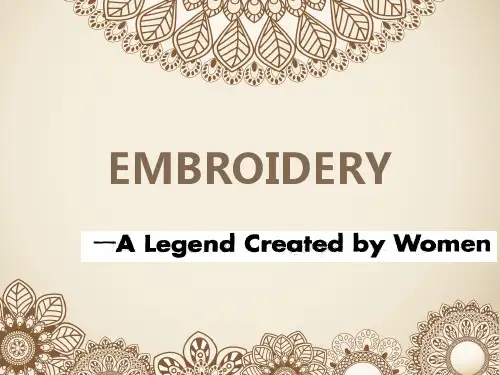
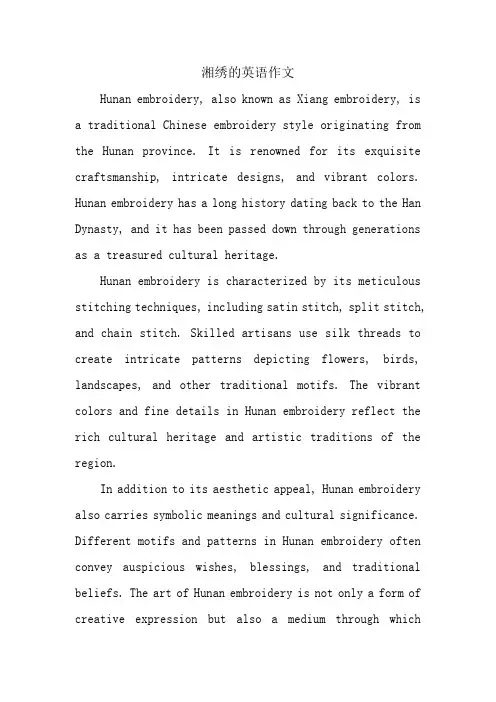
湘绣的英语作文Hunan embroidery, also known as Xiang embroidery, is a traditional Chinese embroidery style originating from the Hunan province. It is renowned for its exquisite craftsmanship, intricate designs, and vibrant colors. Hunan embroidery has a long history dating back to the Han Dynasty, and it has been passed down through generations as a treasured cultural heritage.Hunan embroidery is characterized by its meticulous stitching techniques, including satin stitch, split stitch, and chain stitch. Skilled artisans use silk threads to create intricate patterns depicting flowers, birds, landscapes, and other traditional motifs. The vibrant colors and fine details in Hunan embroidery reflect the rich cultural heritage and artistic traditions of the region.In addition to its aesthetic appeal, Hunan embroidery also carries symbolic meanings and cultural significance. Different motifs and patterns in Hunan embroidery often convey auspicious wishes, blessings, and traditional beliefs. The art of Hunan embroidery is not only a form of creative expression but also a medium through whichcultural values and stories are preserved and passed down.Hunan embroidery has gained recognition both domestically and internationally for its artistic value and cultural significance. It has been showcased in exhibitions, museums, and cultural events, attracting admirers from around the world. Through the art of Hunan embroidery, the beauty and cultural richness of Hunan province are celebrated and shared with a global audience.中文翻译:湖南绣,又称湘绣,是一种源自中国湖南省的传统刺绣风格。
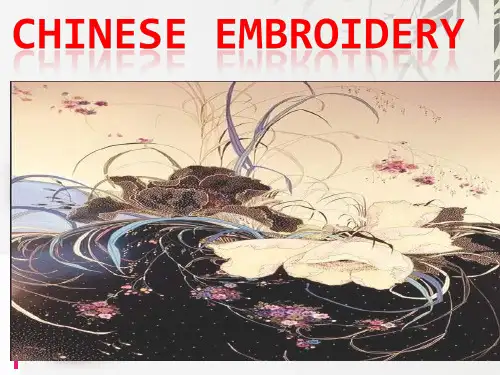
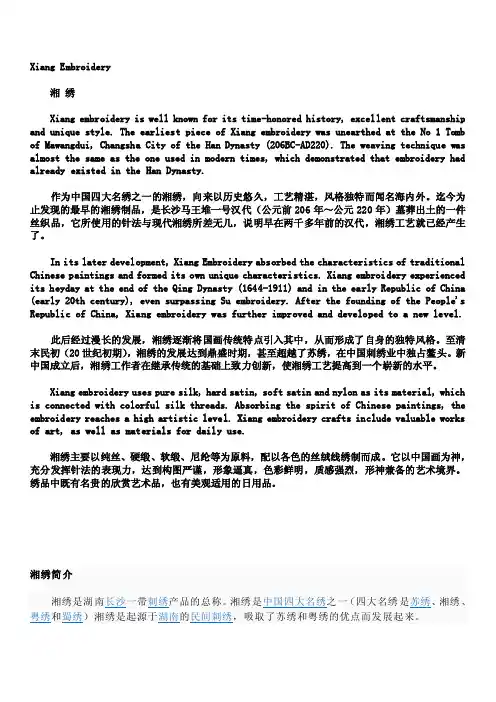
Xiang Embroidery湘绣Xiang embroidery is well known for its time-honored history, excellent craftsmanship and unique style. The earliest piece of Xiang embroidery was unearthed at the No 1 Tomb of Mawangdui, Changsha City of the Han Dynasty (206BC-AD220). The weaving technique was almost the same as the one used in modern times, which demonstrated that embroidery had already existed in the Han Dynasty.作为中国四大名绣之一的湘绣,向来以历史悠久,工艺精湛,风格独特而闻名海内外。
迄今为止发现的最早的湘绣制品,是长沙马王堆一号汉代(公元前206年~公元220年)墓葬出土的一件丝织品,它所使用的针法与现代湘绣所差无几,说明早在两千多年前的汉代,湘绣工艺就已经产生了。
In its later development, Xiang Embroidery absorbed the characteristics of traditional Chinese paintings and formed its own unique characteristics. Xiang embroidery experienced its heyday at the end of the Qing Dynasty (1644-1911) and in the early Republic of China (early 20th century), even surpassing Su embroidery. After the founding of the People's Republic of China, Xiang embroidery was further improved and developed to a new level.此后经过漫长的发展,湘绣逐渐将国画传统特点引入其中,从而形成了自身的独特风格。
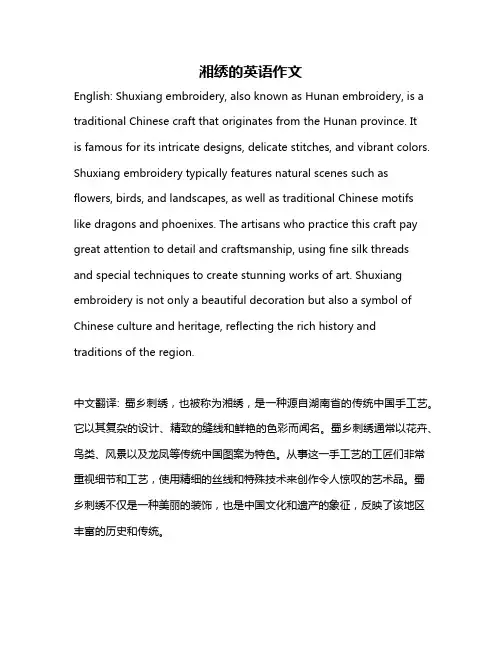
湘绣的英语作文English: Shuxiang embroidery, also known as Hunan embroidery, is a traditional Chinese craft that originates from the Hunan province. Itis famous for its intricate designs, delicate stitches, and vibrant colors. Shuxiang embroidery typically features natural scenes such as flowers, birds, and landscapes, as well as traditional Chinese motifs like dragons and phoenixes. The artisans who practice this craft pay great attention to detail and craftsmanship, using fine silk threads and special techniques to create stunning works of art. Shuxiang embroidery is not only a beautiful decoration but also a symbol of Chinese culture and heritage, reflecting the rich history and traditions of the region.中文翻译: 蜀乡刺绣,也被称为湘绣,是一种源自湖南省的传统中国手工艺。
它以其复杂的设计、精致的缝线和鲜艳的色彩而闻名。
蜀乡刺绣通常以花卉、鸟类、风景以及龙凤等传统中国图案为特色。
从事这一手工艺的工匠们非常重视细节和工艺,使用精细的丝线和特殊技术来创作令人惊叹的艺术品。
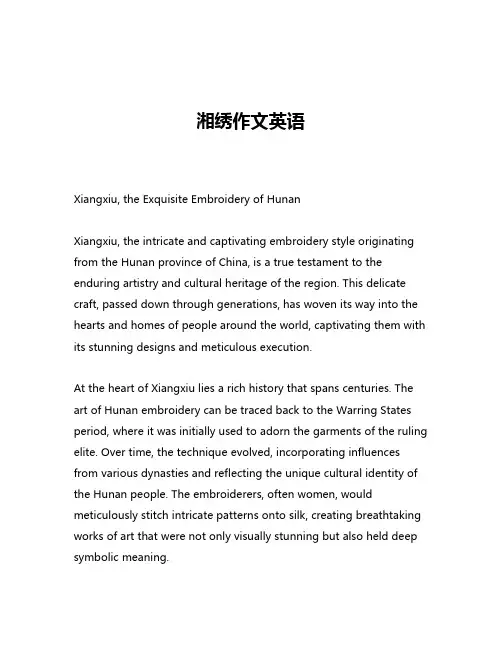
湘绣作文英语Xiangxiu, the Exquisite Embroidery of HunanXiangxiu, the intricate and captivating embroidery style originating from the Hunan province of China, is a true testament to the enduring artistry and cultural heritage of the region. This delicate craft, passed down through generations, has woven its way into the hearts and homes of people around the world, captivating them with its stunning designs and meticulous execution.At the heart of Xiangxiu lies a rich history that spans centuries. The art of Hunan embroidery can be traced back to the Warring States period, where it was initially used to adorn the garments of the ruling elite. Over time, the technique evolved, incorporating influences from various dynasties and reflecting the unique cultural identity of the Hunan people. The embroiderers, often women, would meticulously stitch intricate patterns onto silk, creating breathtaking works of art that were not only visually stunning but also held deep symbolic meaning.One of the defining features of Xiangxiu is the intricate and intricate patterns that adorn the fabric. From delicate floral motifs to intricate depictions of mythical creatures, the embroiderers of Hunan have mastered the art of creating designs that captivate the eye and tell a story. The attention to detail is truly remarkable, with each stitch carefully placed to create a seamless and harmonious composition.The process of creating Xiangxiu is a labor of love, requiring immense skill, patience, and dedication. The embroiderers begin by carefully selecting the finest silk threads, often sourced from local silkworms, and then meticulously plan the design. The stitching process itself is a complex and time-consuming endeavor, with the embroiderers using a variety of techniques, including satin stitch, stem stitch, and couching, to bring the designs to life.As the embroidery takes shape, the embroiderers must exercise great precision and control, ensuring that each stitch is perfectly aligned and that the overall composition is balanced and visually harmonious. This attention to detail is what sets Xiangxiu apart, as the finished products are not merely decorative, but true works of art that capture the essence of Hunan culture.The enduring popularity of Xiangxiu can be attributed to the deep cultural significance that it holds for the people of Hunan. The intricate designs often depict scenes from daily life, mythologicalfigures, and auspicious symbols, imbuing the embroidery with a sense of identity and belonging. For many Hunan residents, Xiangxiu is not just a craft, but a way of life, a tangible connection to their heritage and a source of great pride.Beyond its cultural significance, Xiangxiu has also gained recognition for its artistic merit, with the intricate embroidery being celebrated in galleries and museums around the world. The delicate and intricate nature of the craft has captivated art enthusiasts and collectors, who appreciate the skill and artistry that goes into each piece.In recent years, there has been a renewed interest in preserving and promoting the art of Xiangxiu. Governments and cultural organizations have invested in initiatives to support the embroiderers, providing them with resources, training, and opportunities to showcase their work. This has helped to ensure that the traditions and techniques of Hunan embroidery are passed down to future generations, ensuring that this unique and captivating art form continues to thrive.As we explore the world of Xiangxiu, we are not just admiring a beautiful craft, but also delving into the rich cultural tapestry of the Hunan province. Each stitch, each design, and each finished product tells a story, a testament to the resilience, creativity, and cultural pride of the Hunan people. It is a testament to the power of art totranscend boundaries and connect people across the globe, inspiring awe, wonder, and a deeper appreciation for the beauty and diversity of human expression.In conclusion, Xiangxiu, the exquisite embroidery of Hunan, is a true masterpiece of human creativity and cultural heritage. From its humble beginnings to its global recognition, this captivating art form continues to captivate and inspire, reminding us of the enduring power of human artistry and the enduring significance of our cultural traditions.。

开场白—王女士是湘绣大师英语作文Opening Remarks – Ms. Wang, the Master of Hunan EmbroideryLadies and gentlemen, esteemed guests, it is my great honor to welcome you all to today's special event, where we have the privilege of learning from one of the most renowned figures in the world of Hunan Embroidery – Ms. Wang.Ms. Wang is not just a master of her craft, she is a true artist whose skill and creativity have made a lasting impact on the world of embroidery. Her work is truly awe-inspiring, with intricate designs and beautiful patterns that showcase the rich cultural heritage of Hunan province.As we gather here today, we have the opportunity to witness firsthand the magic of Hunan Embroidery and to learn from Ms. Wang, who has dedicated her life to preserving and promoting this traditional art form.With her expert guidance and deep knowledge of Hunan Embroidery, we are sure to gain valuable insights into the techniques and traditions that make this art form so unique and special. Ms. Wang's passion for embroidery is truly contagious,and we are fortunate to have her share her wisdom and expertise with us today.In conclusion, I would like to express my deepest gratitude to Ms. Wang for gracing us with her presence and for her dedication to preserving the art of Hunan Embroidery. I hope that today's event will inspire all of us to appreciate and support the rich cultural heritage of embroidery, and to carry on this beautiful tradition for generations to come.Thank you and enjoy the event!。
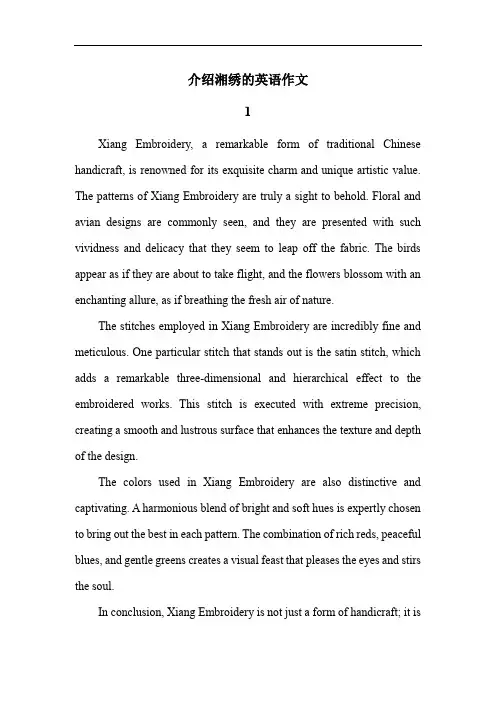
介绍湘绣的英语作文1Xiang Embroidery, a remarkable form of traditional Chinese handicraft, is renowned for its exquisite charm and unique artistic value. The patterns of Xiang Embroidery are truly a sight to behold. Floral and avian designs are commonly seen, and they are presented with such vividness and delicacy that they seem to leap off the fabric. The birds appear as if they are about to take flight, and the flowers blossom with an enchanting allure, as if breathing the fresh air of nature.The stitches employed in Xiang Embroidery are incredibly fine and meticulous. One particular stitch that stands out is the satin stitch, which adds a remarkable three-dimensional and hierarchical effect to the embroidered works. This stitch is executed with extreme precision, creating a smooth and lustrous surface that enhances the texture and depth of the design.The colors used in Xiang Embroidery are also distinctive and captivating. A harmonious blend of bright and soft hues is expertly chosen to bring out the best in each pattern. The combination of rich reds, peaceful blues, and gentle greens creates a visual feast that pleases the eyes and stirs the soul.In conclusion, Xiang Embroidery is not just a form of handicraft; it isa testament to the ingenuity and artistic prowess of the artisans. Its beauty lies in the intricate patterns, the delicate stitches, and the unique color palette, which together make it a true masterpiece of Chinese culture.2Xiang Embroidery, a remarkable form of traditional Chinese handicraft, holds a significant place in the rich tapestry of Chinese culture. Its history can be traced back to ancient times, where it was highly regarded for its exquisite craftsmanship and artistic beauty.In the past, Xiang Embroidery was not only an art form but also a symbol of status and refinement. It was often used to adorn the clothing and accessories of the nobility and the wealthy, showcasing their taste and prestige. The intricate patterns and delicate stitches were painstakingly created by skilled artisans, who passed down their techniques from generation to generation.One of the most fascinating aspects of Xiang Embroidery is its incorporation of traditional Chinese motifs and symbols. These elements carry deep cultural meanings and tell stories of history, mythology, and nature. For instance, the phoenix and the peony are common motifs, representing auspiciousness and prosperity.There is also a charming legend associated with Xiang Embroidery. It is said that a young girl, with an exceptional talent for embroidery, created a masterpiece that was so lifelike it attracted the attention of the gods. Herwork was considered a divine gift, highlighting the magical allure and spiritual connection of Xiang Embroidery.Today, Xiang Embroidery continues to thrive, preserving the essence of traditional techniques while adapting to modern aesthetics. It serves as a testament to the creativity and ingenuity of the Chinese people, and a bridge connecting the past and the present. Its cultural significance remains profound, inspiring people to appreciate the beauty and wisdom of traditional craftsmanship.3Xiang embroidery is a remarkable form of traditional Chinese handicraft that showcases exquisite craftsmanship and artistic beauty. The process of creating Xiang embroidery is both intricate and fascinating.To start with, the preparation of materials is of great significance. High-quality silk fabric and fine silk threads in various colors are selected. The silk fabric needs to be carefully cleaned and stretched to ensure its smoothness and flatness.Next comes the design stage. Skilled artisans draw inspiration from nature, history, and culture to create unique and elegant patterns. These patterns are then transferred onto the silk fabric with meticulous precision.The actual embroidery process is highly demanding. The embroiderer holds the needle delicately and inserts the silk thread with dexterous movements. One of the key techniques is the use of different stitch types,such as the satin stitch and the split stitch. The satin stitch creates a smooth and lustrous surface, while the split stitch adds texture and depth to the design.Throughout the process, the embroiderer must maintain concentration and patience. Every stitch is a testament to their skill and dedication. The final product is a masterpiece that combines artistry and craftsmanship, reflecting the rich cultural heritage of Xiang embroidery.In conclusion, Xiang embroidery is not just an art form but a legacy that continues to charm and inspire people with its elegance and sophistication.4Xiang embroidery, a traditional handicraft with a long history and profound cultural heritage, has always been a gem of Chinese art. In modern society, its inheritance and innovation have become an important topic.Modern designers have ingeniously integrated elements of Xiang embroidery into fashionable clothing, breathing new life into this ancient art form. The exquisite patterns and delicate stitches of Xiang embroidery add a unique charm and elegance to the clothing, making them stand out on the fashion stage. For example, some designers use Xiang embroidery to decorate the collars, cuffs or hems of dresses, creating a sense of luxury and refinement.In addition, new technologies have also played a significant role in improving the production of Xiang embroidery. Advanced computer-aided design systems enable more precise and complex patterns to be created, expanding the creative space for embroiderers. Meanwhile, new materials and tools have improved the efficiency and quality of production, making Xiang embroidery more accessible to a wider audience.The inheritance and innovation of Xiang embroidery not only preserve our cultural traditions but also promote their integration into modern life. It allows this ancient art to continue to shine in the modern era, bringing beauty and inspiration to people's lives. We should actively support and encourage such innovations to ensure that Xiang embroidery remains an important part of our cultural heritage for generations to come.5Xiang Embroidery, a remarkable form of traditional Chinese embroidery, holds a unique position among various embroidery styles. When comparing Xiang Embroidery with other well-known embroidery schools, such as Su Embroidery, distinct differences and similarities come to light.In terms of stitch techniques, Xiang Embroidery is known for its intricate and diverse stitches. The embroiderers master a wide range of stitches, creating elaborate and detailed patterns. Unlike Su Embroidery, which often features more uniform and delicate stitches, Xiang Embroideryincorporates a combination of bold and fine stitches, adding a sense of depth and texture to the works.Patterns play a significant role in differentiating these two styles. Xiang Embroidery showcases a rich variety of patterns, often depicting scenes from nature and local folklore. The patterns are bold and vivid, expressing the passion and vitality of the region. Su Embroidery, on the other hand, is renowned for its elegant and refined patterns, usually depicting landscapes and traditional motifs with a more delicate touch.When it comes to the use of colors, Xiang Embroidery makes bold and vibrant choices. The colors are intense and contrast sharply, creating a visually striking effect. In contrast, Su Embroidery leans towards more soft and harmonious color combinations, giving a sense of elegance and tranquility.The unique characteristics of Xiang Embroidery not only reflect the cultural heritage and artistic traditions of the region but also contribute to the diversity and richness of Chinese embroidery as a whole. It is through these comparisons that we can better appreciate the charm and value of each embroidery style.。
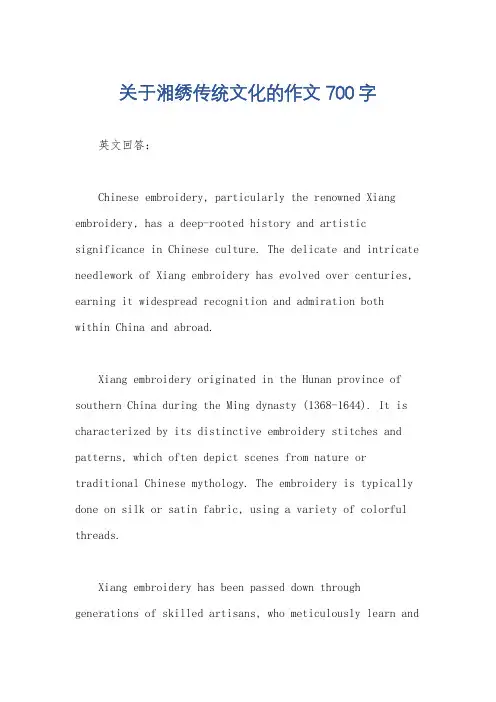
关于湘绣传统文化的作文700字英文回答:Chinese embroidery, particularly the renowned Xiang embroidery, has a deep-rooted history and artistic significance in Chinese culture. The delicate and intricate needlework of Xiang embroidery has evolved over centuries, earning it widespread recognition and admiration bothwithin China and abroad.Xiang embroidery originated in the Hunan province of southern China during the Ming dynasty (1368-1644). It is characterized by its distinctive embroidery stitches and patterns, which often depict scenes from nature or traditional Chinese mythology. The embroidery is typically done on silk or satin fabric, using a variety of colorful threads.Xiang embroidery has been passed down through generations of skilled artisans, who meticulously learn andpractice the techniques required to create these exquisite works of art. The embroidery stitches are precise and delicate, creating a rich and textured appearance. The patterns are often highly detailed and vibrant, with a strong emphasis on balance and harmony.One of the unique features of Xiang embroidery is its use of "stump work," a technique that involves addingthree-dimensional elements to the embroidery. Thistechnique gives the embroidery a sense of depth and realism. Another distinctive characteristic is the use of "gold work," where gold threads are incorporated into the embroidery to create intricate designs.Xiang embroidery is not only a form of artistic expression but also a cultural tradition that has been preserved and celebrated for centuries. The embroidery has been used to decorate clothing, accessories, and other items, and has played a significant role in Chinesefestivals and rituals.In recent years, Xiang embroidery has experienced arevival of interest both in China and internationally. The exquisite craftsmanship and cultural significance of Xiang embroidery have made it a highly sought-after art form. Museums and galleries around the world have showcased Xiang embroidery exhibitions, introducing this ancient Chinese tradition to a wider audience.中文回答:湘绣,是中国著名的传统刺绣技艺,在中华文化中有着悠久的历史和艺术价值。
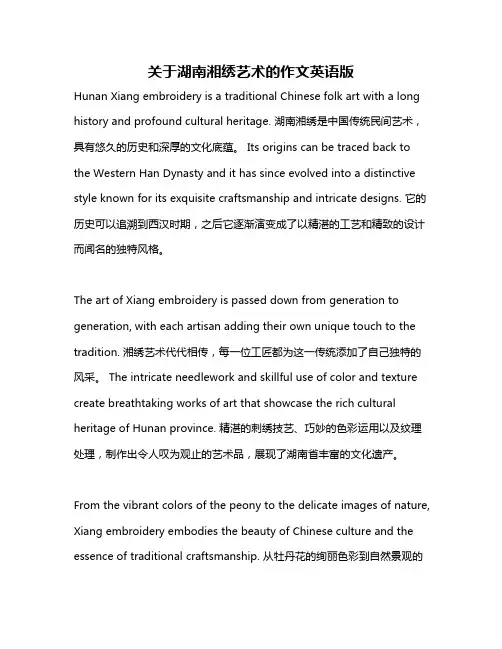
关于湖南湘绣艺术的作文英语版Hunan Xiang embroidery is a traditional Chinese folk art with a long history and profound cultural heritage. 湖南湘绣是中国传统民间艺术,具有悠久的历史和深厚的文化底蕴。
Its origins can be traced back to the Western Han Dynasty and it has since evolved into a distinctive style known for its exquisite craftsmanship and intricate designs. 它的历史可以追溯到西汉时期,之后它逐渐演变成了以精湛的工艺和精致的设计而闻名的独特风格。
The art of Xiang embroidery is passed down from generation to generation, with each artisan adding their own unique touch to the tradition. 湘绣艺术代代相传,每一位工匠都为这一传统添加了自己独特的风采。
The intricate needlework and skillful use of color and texture create breathtaking works of art that showcase the rich cultural heritage of Hunan province. 精湛的刺绣技艺、巧妙的色彩运用以及纹理处理,制作出令人叹为观止的艺术品,展现了湖南省丰富的文化遗产。
From the vibrant colors of the peony to the delicate images of nature, Xiang embroidery embodies the beauty of Chinese culture and the essence of traditional craftsmanship. 从牡丹花的绚丽色彩到自然景观的精致画面,湘绣体现了中国文化的美丽和传统工艺的精髓。
关于湖南湘绣艺术的作文英语版Nestled in the heart of China, Hunan province is renowned for its rich cultural heritage, one of which is the exquisite art of Xiang embroidery. This ancient craft, synonymous with the region, has withstood the test of time, evolving into a vibrant expression of both tradition and innovation. Xiang embroidery, with its intricate designs and meticulous stitching, tells a story of cultural continuity and artistic excellence.The history of Xiang embroidery traces back to the Song Dynasty (960-1279), when Hunan was a prosperous center of trade and culture. The art form was initially influenced by the embroidery styles of neighboring regions but gradually developed its own unique characteristics. Over the centuries, Xiang embroidery has been passed down through generations, with each new artisan adding their own touch and innovations to the craft.The essence of Xiang embroidery lies in its meticulous attention to detail. Using high-quality silk thread,skilled artisans create intricate patterns on a variety of fabrics, often depicting scenes from nature, folklore, andmythology. The threads are manipulated with such precision that even the slightest nuances of color and texture are captured, resulting in works of art that are both visually arresting and deeply cultural.The designs of Xiang embroidery are often symmetrical, reflecting the harmonious balance and aesthetic sensibility of traditional Chinese culture. The motifs, ranging from flowers and birds to landscapes and figures, are often enriched with symbolic meanings, reflecting the values and aspirations of the people. For instance, the lotus flower, a common motif in Xiang embroidery, represents purity and enlightenment.The art of Xiang embroidery is not limited to visual aesthetics; it is also a profound expression of cultural identity. The patterns and motifs often reflect the traditions, beliefs, and daily lives of the Hunan people, serving as a桥梁 between the past and the present. By embroidering these designs onto fabrics, artisans are not just creating beautiful works of art; they are also preserving and passing down a rich cultural heritage.In recent years, Xiang embroidery has gained recognition both domestically and internationally, with many artisans receiving accolades for their craftsmanship. This recognition has not only boosted the popularity of Xiang embroidery but has also encouraged younger generations to take interest in this traditional art form. Many schools and community centers now offer courses on Xiang embroidery, ensuring that this centuries-old craft survives and thrives in the modern era.In conclusion, Hunan Xiang embroidery is not just a craft; it is a cultural phenomenon that embodies the spirit of the Hunan people. It is a testament to the resilience and adaptability of traditional arts in the face of modernization and globalization. As we move forward into the future, it is crucial that we continue to cherish and preserve this rich cultural heritage, ensuring that the splendor of Hunan Xiang embroidery shines on for generations to come.**湖南湘绣艺术的辉煌:文化与艺术的融合**位于中国中部的湖南省以其丰富的文化遗产而闻名,其中之一就是精致的湘绣艺术。
The Splendor of Xiang Embroidery: ACultural Treasure of ChinaNestled in the heart of China, Hunan province boasts a rich cultural heritage, one of which is the renowned Xiang embroidery. This intricate form of art, with its roots tracing back to ancient times, has evolved over centuries to become a symbol of elegance and sophistication. Xiang embroidery not only embodies the skilled craftsmanship of generations but also serves as a testament to the rich cultural identity of the Hunan region.The essence of Xiang embroidery lies in its meticulous detail and vibrant color palette. Each stitch, meticulously crafted using silk or cotton thread, tells a story of cultural continuity and artistic expression. The designs, often featuring traditional motifs like flowers, birds, and landscapes, are meticulously outlined and filled with intricate patterns, creating a visual feast for the eyes. The use of bright and vivid colors further enhances the aesthetic appeal of Xiang embroidery, making it stand out among other forms of embroidery.The art of Xiang embroidery is passed down through generations, often from mother to daughter, making it a family tradition that is deeply ingrained in the cultural fabric of Hunan. The skill requires patience, dedication, and a keen eye for detail, making it a highly respected craft among the local community. The artisans whospecialize in this craft are held in high esteem for their ability to transform plain fabrics into works of art.The beauty and sophistication of Xiang embroidery have not been confined to the domestic sphere. It has found its way into the global market, becoming a prized possession among collectors and art lovers alike. Its unique style and intricate designs have garnered recognition and appreciation from around the world, making it a symbol of Chinese cultural excellence.In today's fast-paced world, Xiang embroidery serves as a bridge between the past and the present, connecting generations and cultures. It is a powerful reminder of the rich cultural heritage of China and a testament to the enduring beauty of traditional crafts. As we move forwardin the age of technology and modernization, it is importantto cherish and preserve such cultural treasures, ensuring that they continue to inspire and captivate future generations.湘绣:中国文化的瑰宝位于中国中部的湖南省,拥有丰富的文化遗产,其中之一便是脍炙人口的湘绣。
关于湘绣文化的作文素材英文回答:Introduction:Xiang Embroidery, also known as Hunan Embroidery, is a renowned Chinese folk art that originated in the Hunan province of China. With a history spanning over a thousand years, Xiang Embroidery has played a significant role in Chinese cultural heritage.Characteristics of Xiang Embroidery:Xiang Embroidery is characterized by its exquisite craftsmanship, vibrant colors, and intricate designs. The embroidery is traditionally done on silk or satin fabric menggunakan various stitches, including satin stitch, couching stitch, and loop stitch. The colors used in Xiang Embroidery are typically bright and bold, with red, gold, and blue being the most common.Themes and Motifs in Xiang Embroidery:Xiang Embroidery often depicts scenes from nature, such as flowers, birds, and animals. Other common themes include historical figures, mythological characters, and auspicious symbols. The motifs used in Xiang Embroidery are often symbolic, representing such concepts as good fortune, longevity, and harmony.History of Xiang Embroidery:Xiang Embroidery has a rich and long history, dating back to the Tang dynasty (618-907). During the Song dynasty (960-1279), Xiang Embroidery flourished and became a popular export item. In the Ming dynasty (1368-1644), Xiang Embroidery reached its peak of development, with the establishment of imperial workshops in Beijing.Cultural Significance of Xiang Embroidery:Xiang Embroidery is not only a beautiful art form butalso holds significant cultural importance. It reflects the traditions, beliefs, and aspirations of the people of Hunan. Xiang Embroidery is often used in traditional Chinese clothing, accessories, and home furnishings. It is also a popular collector's item and is displayed in museums and galleries around the world.Preservation and Promotion of Xiang Embroidery:In recent years, there has been a growing effort to preserve and promote Xiang Embroidery. The Chinese government has designated it as a national intangible cultural heritage. There are also numerous schools and workshops dedicated to teaching Xiang Embroidery to new generations.Conclusion:Xiang Embroidery is a treasured Chinese folk art that continues to captivate people worldwide. Its exquisite craftsmanship, vibrant colors, and intricate designs makeit a unique and beautiful expression of Chinese culture.中文回答:湘绣,中国传统的民间艺术。
刺绣英语简介Embroidery is a brilliant pearl in Chinese art. In the costume culture , it occupies an important position in the treasure of the Chinese traditional arts and crafts, and is an important part of Chinese nation. It represents the wisdom of Chinese people.Major Styles of Chinese Embroidery:Su Embroidery (苏绣)Yue Embroidery (粤绣)Shu Embroidery (蜀绣)Xiang Embroidery (湘绣)Su embroidery is the general name for embroidery products in areas around Suzhou, JiangsuProvince with a history of more than 2000 years.History:The craft, which dates back to the Three Kingdoms Period (220-280), became a sideline of people in the Suzhou area during the Ming Dynasty (1368-1644). Well known for its smoothness and delicateness, Su embroidery won Suzhou the title City of Embroidery in the Qing Dynasty. In the mid and late Qing, Su embroidery experienced further developments involving works of double-sided embroideringFeature: Su embroideryhas a Strong local characteristics and its weaving techniques are characterized by the following: the product surface must be flat, the rim must be neat, the needle must be thin, the lines must be dense, the color must be harmonious and bright and the picture must be even. Double-sided embroidery is an excellent representative of Su embroidery.Yue Embroidery (粤绣Also called Guang embroidery, Yue embroidery is a general name for embroidery products of the regions of Guangzhou, Shantou, Zhongshan, Panyu and Shunde in Guangdong Province History: According to historical records Yue embroidery firstbecame famous was in the first year of Yongzhen during the tang dynasty. The prosperous Guangzhou Port of the Song Dynasty promoted the development of Yue embroidery, which began to be exported at that timeFeature :Influenced by national folk art, Y ue embroidery formed its own unique characteristics. The embroidered pictures are mainly of dragons and phoenixes, and flowers and birds, with neat designs and strong, contrasting colorsShu Embroidery (蜀绣Also called Chuan embroidery, Shu embroidery is the general name for embroidery products in areas around Chengdu, Sichuan ProvinceHistory Shu embroidery enjoys a long history. As early as the Han Dynasty, Shu embroidery was already famous. The central government even designated an office in this area for its administration Shu embroidery experienced its peak development in the Song Dynasty (960-1279), ranking first in both production and excellence. In the mid-Qing Dynasty, the Shu embroidery industry was formedFeature :Originating among the folk people in the west of Sichuan Province, Shu embroidery formed its own unique characteristics: smooth, bright, neat and influenced by the geographical environment, customs and cultures. The works incorporated flowers, leaves, animals, mountains, rivers and human figures as their themes. Altogether, there are 122 approaches in 12 categories for weaving.Xiang Embroidery (湘绣)Xiang embroidery is well known for its time-honored history, excellent craftsmanship and unique style. The earliest piece of Xiang embroidery was unearthed at the No 1 Tomb ofMawangdui,Changsha City of the Han Dynasty (206BC-AD220History:In its later development, Xiang Embroidery absorbed the characteristics of traditional Chinese paintings and formed its own unique characteristics. Xiang embroidery experienced its heyday at the end of the Qing Dynasty (1644-1911) and in the early Republic of China (early 20th century), even surpassing Su embroidery. After the founding of the People's Republic of China, Xiang embroidery was further improved and developed to a new level.Feature :Xiang embroidery uses pure silk, hard satin, soft satin and nylon as its material, which is connected with colorful silk threads. Absorbing the spirit of Chinese paintings, the embroidery reaches a high artistic level.other embroidery styles in ChinaGu embroidery, Long embroidery, Xinzhou embroidery, Jinnan embroidery, and a number of ethnic styles used by the different ethnic minority groups living in China.。